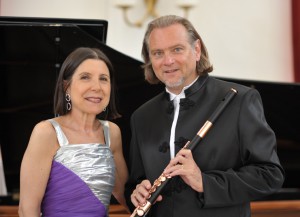French flutist Patrick Gallois and Vienna- based pianist Maria Prinz combined their talents in a program called “Vienna Meets Paris”, the first half dedicated to Vienna, and the second half, Paris. Their no-nonsense manner upon entering the stage reflected the lives of busy professionals, but from the first sterling tones it was obvious that this was going to be something memorable.
Opening with Mr. Gallois’s arrangement of the Sonata in F major, K. 376 of Mozart, the duo gave notice that they were one with this piece, which one might expect as they have recently recorded this work for Naxos (http://www.naxos.com/catalogue/item.asp?item_code=8.573033). Ms. Prinz, who has collaborated with other prominent flutists, never allowed her playing to become overpowering, even though the piano was on the full stick. It is also a credit to Mr. Gallois that he projected his playing with such ability that he was never in any danger of being covered. Mr. Gallois has a full-bodied tone that sings and soars, but never allows any overblowing. He also has an assured technique that allows him to make short work of difficult passages. It was an auspicious start.
Beethoven’s National Airs with variations, Op.105 and Op. 107 were commissioned by the Scottish folk-song collector and publisher George Thompson. A Schüsserl und a Reindel, Op. 105, No. 3 and St. Patrick’s Day, Op 107, No. 4, were featured. As per the request of Thompson (“You must write the variations in a familiar, easy, and slightly brilliant style, so that the greatest number of our ladies can play and enjoy them”), Beethoven gives the pianist the bulk of the difficulty in some brilliant writing. Even “easy” pieces can be dangerous, but Mr. Gallois did not fall into this trap. He played with finesse, adding his own touches of brilliance, while Ms. Prinz’s star shone brightly in what really are piano works with flute added. Ending the first half, three Schubert songs, Gute Nach, Das Fischermädchen and Ständchen, as transcribed by Theobald Böhm (1794-1881). Böhm, who can be considered the father of the modern Western flute and the corresponding fingering system still In use, did for the flute what Liszt did for the piano in his transcriptions of these songs. Mr. Gallois and Ms. Prinz played these songs with flair, but also with sensitivity. It was a thoughtful and melodious departure from Vienna.
The second half took the listener to Paris with three works by French composers written explicitly for the flute. Philippe Gaubert (1879-1941) wrote in the style of his great contemporaries Franck, Debussy, and Ravel. His Sonata for Flute and Piano No. 2 is unmistakably impressionistic in its tonal form and written with idiomatic detail that one would expect from one so familiar with the flute. Mr. Gallois captured the singing lines, the magical, and the mystical with what seemed to be the greatest of ease. This is not at all surprising considering the connection Mr. Gallois has with this work. The baton has been passed through the generations when considers the musical genealogy – Gaubert to his student Marcel Moyse to his student Joseph Rampal, to his son Jean-Pierre, to Jean-Pierre’s student Gallois.
La merle noire (The Blackbird) from Olivier Messiaen followed. Written in 1952 as a test piece for the Paris Conservatoire, this short composition was one of Messiaen’s earliest works to use the concept of notated birdsong, which was a life-long fascination of him. Mr. Gallois captured the warbling element with great imagination, and both he and Ms. Prinz conveyed its dizzying effects in a captivating performance. The Sonata for Flute and Piano by Francis Poulenc closed the program. This work is among the best-loved and most frequently performed works in the flute repertoire. It was composed with Jean-Pierre Rampal in mind. In his memoirs, Rampal mentions a phone call from Poulenc- “Jean-Pierre,” said Poulenc, “you know you’ve always wanted me to write a sonata for flute and piano? Well, I’m going to, “he said. “And the best thing is that the Americans will pay for it! I’ve been commissioned by the Coolidge Foundation to write a chamber piece in memory of Elizabeth (Sprague) Coolidge. I never knew her, so I think the piece is yours.” Brimming with brilliance, this work is vintage Poulenc, and a successful performance requires a player who can “do it all”. Mr. Gallois brought out the bursts of optimistic energy with confidence in the first movement, the longing, wistfulness of the second movement, and the joyous whimsy of the “off to the races” finale. Ms. Prinz was with him every step of the way. Played with élan, it was a winning performance. Encores followed, of which I especially liked the “Meditation” from Massenet’s Thaïs, played with delicate beauty.
A final thought – it was particularly striking how synchronized Mr. Gallois and Ms. Prinz were throughout. It was as if they were of the same mind, a “mind-meld” that found them in perfect ensemble without any visual contact or physical cues such as nodding. I have seen other duos that had excellent rapport, but this was truly something above and beyond the norm. This is a pairing that has unlimited potential if they decide to continue as a duo.

